
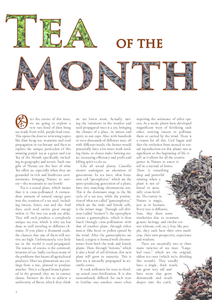 |
|
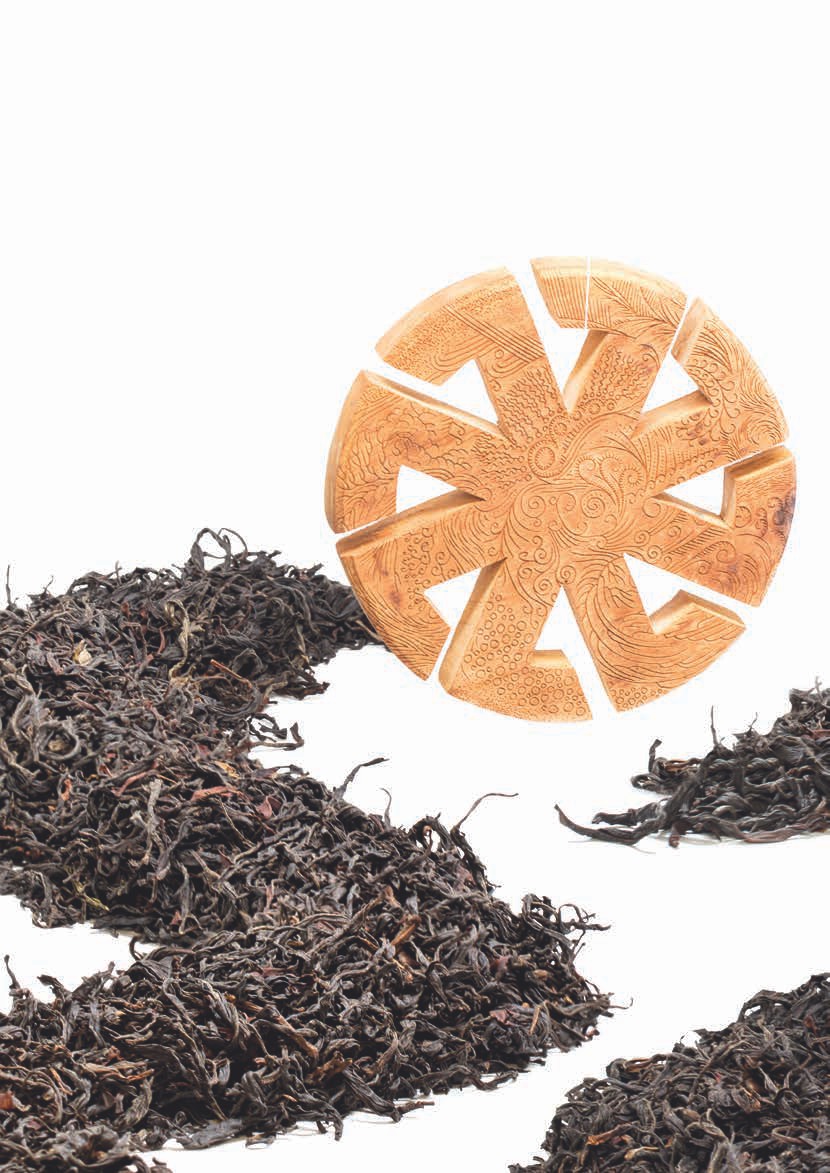
Over the course of this issue, we are going to explore a very rare kind of dian hong tea made from wild, purple-bud trees. This opens the door to reviewing topics like dian hong tea, mutation and seed propagation in tea botany and then to explore the unique particulars of this amazing purple tea as a genre and our Tea of the Month specifically, including its geography and terroir. Such rare gifts of Nature are the best of what Tea offers us, especially when they are grounded in rich and biodiverse environments, bringing Nature to society - the mountain to our bowls!
Tea is a sexual plant, which means that it is cross-pollinated. A tremendous amount of natural energy goes into the creation of a tea seed, including insects, forest, sun and sky. And thus, each seed carries great energy within it. No two tea seeds are alike. They will each produce a completely unique tea tree, which is why tea has done so well traveling to different climates. If you plant a thousand seeds, the chances that one of them will survive are high. Unfortunately, very little tea in the world is seed-propagated. The reason, of course, is the commoditization of tea. Sadly, tea faces many of the problems that haunt all agricultural products: Most tea plantations use cuttings from a tree, planted to produce another. This is a clipped branch planted in the ground; they are in essence clones. Farmers do this to achieve a uniformity of flavor, which they think we tea lovers want. Actually, tasting the variations in the weather and seed-propagated trees is a joy, bringing the climate of a place, its nature and spirit, to our cups. Also, with hundreds or even thousands of different trees, all with different needs, the farmer would potentially have a lot more work tending them, so clones make farming easier, increasing efficiency and profit and killing spirit to do so.
Like all sexual plants, Camellia sinensis undergoes an alteration of generations. In tea trees, what botanists call "sporophytes," which are the spore-producing generation of a plant, have two matching chromosome sets. This is the dominant stage in the life cycle of a tea tree, while the production of what are called "gametophytes," which are the male and female cells, is the minor stage. Through cell division (called "meiosis"), the sporophyte creates a gametophyte, which is then fused through cross-pollination with that of another plant, through either insects (like bees) or pollen spread by the wind. After the gametophytes are fused, a zygote is formed with chromosomes from both the male and female plants. Then, through "mitosis," which is also a kind of cell division, this new plant will grow to maturity. This is how tea is naturally propagated in scientific terms.
It took millennia for trees to develop sexual cross-fertilization. It is also tremendously difficult for such trees to fertilize one another, more often requiring the assistance of other species. As a result, plants have developed magnificent ways of fertilizing each other, enticing insects to pollinate them or carried by the wind. There is a reason for all this. Carl Sagan said that the evolution from asexual to sexual reproduction on this planet was as significant as the beginning of life itself, as it allows for all the creative power in Nature to assert itself in a myriad of forms. There is something deep and powerful missing when a plant is not allowed to naturally cross-fertilize. The variety in Nature is magic, just as in humans. Every tree is different. Sure, they share some similarities due to common genetic heritage and similar terroir (climate, soil, etc.), but, like people, they each have their own medicine, their own perspective, experience and wisdom.
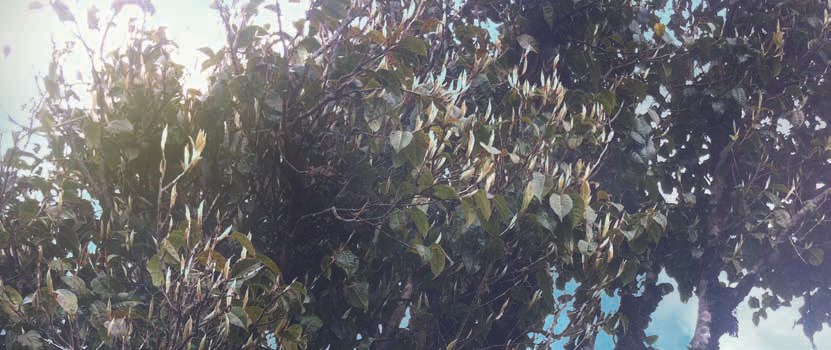
There are essentially two or three main varieties of tea trees: "Largeleaf trees," which are the original, oldest tea trees (which we're drinking this month). They usually have a single, thick trunk, can grow very tall and have roots that grow downwards and much deeper into the earth. As tea moved north, whether naturally or carried by man, it evolved into "small-leaf trees," which are more bush-like. They have many trunks and roots that grow outwards. In fact, the leaves got smaller and smaller as tea moved north - until you get to Japan where the leaves are so small they look like needles after they're rolled! There are then "medium-leaf " trees, like Qimen gongfu red tea, Red Sun Rising or Liu Bao tea. You cannot determine the kind of tree by examining any one leaf, as large-leaf tea trees have small buds and small-leaf trees also have larger leaves once they grow out. You must look at the overall tree - at the largest leaves once they are fully grown. Mature leaves from large-leaf tea trees are much, much larger than leaves from small-leaf trees.
Having reviewed the three main kinds of tea trees, we can now discuss the difference between seed-propagated and cloned tea, which is obvious in several ways. Large-leaf tea trees can live thousands of years. The oldest one we've dated is 3,500 years old! It is about six people around. There are probably older trees out there, or at least there were in the past. There is also a 2,700-year-old tree in Ai Lao. Small-leaf tea trees can live hundreds of years, and some are many centuries old, like the old-growth trees on Phoenix Mountain, which are used to make Dancong oolong. Here's the punch line: The clones on plantations typically live only thirty to fifty years. A few farmers have told us that trees aren't living as long anymore, sometimes as few as fifteen to twenty years. This is because modern farming practices are based on increasing yield at any cost to the environment, so farmers nowadays will rip out clones as soon as their harvest decreases even slightly. This isn't long, as they are fertilized to create more leaves and then are over-harvested. This unnatural, quickened production of tea with agrochemicals eventually wears down the soil as well.
Beyond just the age of the trees, there are several species of birds that love to eat tea seeds. They are rich and oily and full of nutrients. Farmers make cooking oil out of them. It's delicious. More than one farmer has told us that after the second generation of cloning, the birds will no longer eat the tea seeds.
Nature has been creating life for millennia, so it is very unhealthy for us to assume that we can improve or alter Her designs. Our attempts to interfere with Nature rarely take into account all the biodiversity and the infinite, immeasurable connections there are between species. We take control of an environment and monocrop it, controlling a few factors in a huge web of symmetry. This may be smart, but it isn't wise. As we've done this to larger and more diverse areas, our meddling has begun to have a global impact, changing the Environment (capital "E") rather than just the places where we farm.

In fact, none of our creations ever come close to the power or beauty of Nature, especially since we too are one of her greater masterpieces - so all that we create also owes homage to Mother Earth, ultimately. Allowing her creative license is an important aspect of the diversity of life that sustains this planet, and any given environment. When tea is natural and seed-propagated, every single tree is unique. Mutations arise. They each have a place and a hue, and in that way She can create more and varied medicine for us. It is presumptuous to assume that all the variety in tea is human-made, and has to do exclusively with processing, as some authors would suggest. A tremendous amount of variety is natural born, and defies our limited, mind-made categories of what tea genres are.
Though we call such tea varietals "mutations," this should be understood in a way that is all aglow with positivity, as such changes in the genetics of trees are in response to their environment. This means that a harmony with the environment created these changes over time. The mutations of tea trees could be thought of as the environment changing the tea as much as the tea changing within an environment. The two go together. It is only the human mind that separates the tree from its environment as a distinct entity. In truth, a tree is its environment: The soil, climate and biodiversity all flow through it, as its energy flows through other organisms in the form of food, water and even oxygen, which it creates in photosynthesis. When the environment is pristine and rich, filled with the diversity of insects, birds, lizards, snakes and a myriad of other species, including microorganisms, the influence of all these species will be within the tea leaves, and also be a part of the subtle, slow evolutionary pressure that, over long spans of time, results in the survival of new mutations that become varietals, which in turn can "speciate" and become an entirely new species of Camellia. One example of a way in which we can follow the web of interconnectedness in a rich, biodiverse ecology is to see that the insects we humans ordinarily fight to keep out of our agricultural environments are also an essential part of a food chain, and that the waste/manure of the insects, as well as the birds, snakes, lizards and other organisms that eat insects, all help fertilize the soil and the tea trees.
Though it is sometimes referred to as "purple tea," this is actually not a genre of tea but rather a kind of tree (several varietals, actually), which can be found within most genres of tea. Remember that all genres of tea are a complicated blend of varietals and processing techniques. When we say that a tea is a purple tea, we mean that a varietal of tea has a very unique mutation, where its buds are purple to maroon in color. In most varieties of purple tea, the purple buds slowly turn green as they open into mature leaves, changing from inside to out. This lends the tree a beautiful glow, as the buds are all purple and many of the smaller leaves around them are ringed with purple. However, the leaves do stay a dark purplish hue in some varietals.
Purple tea is found in many tea-growing regions, especially where natural seed-propagation has thrived (or once thrived) for centuries, allowing for natural variation in varietal. There are examples in green tea, like "Purple Bamboo Shoot (Zi Sun, 紫筍)" from Zhejiang Province, which is always purplish, and varietals of oolong that occasionally have purple buds, like "Four Seasons of Spring (Si Ji Chun, 四季春)" in Taiwan and the Wuyi Cliff tea varietal called "Iron Arhat (Tie Luo Han, 鐵羅漢)." As you can see, purple tea is found in most genres of tea, even white tea, which many of you know, having drunk our purple-bud "Moonlight White (Yue Guang Bai, 月光白)" from Jinggu in Yunnan.
In Yunnan, there are three main kinds of purple tea: The oldest, pure varietal of "Wild Purple (Ye Sheng Zi, 野生紫)," which is our Tea of the Month (Camellia sinensis var. Assamica Dehongensis). It comes from Dehong. We will discuss this kind more in our discussion of this month's tea. The second is called simply "Purple Bud (Zi Ya, 紫芽)." This natural mutation is found all throughout Yunnan in any species or varietal that is seed-propagated, and therefore allowed to mutate. There are many kinds of such purple-bud tea, including Moonlight White. The last kind of purple tea found in Yunnan is a human-made cultivar called "Purple Beauty (Zi Juan, 紫娟)." Some scholars suggest it was made by crossing purple-hued varietals of Iron Arhat from Wuyi with Assamica from Yunnan, while others claim it to be a native cultivar. This rare cultivar produces a very unique purple liquor of which we have yet to find an organic, or delicious, example. More often, it is a passing curiosity at tea tables in tea shops trying to expose the customer to many kinds of tea.
Purple tea is purple because the trees have produced anthocyanins, which are water-soluble pigments that can be deep purple, maroon, red, black or blue, depending on the pH. Grapes, black rice, blueberries and raspberries are all examples of foods with anthocyanins. Maple leaves, and actually some of the colors found in autumn leaves, are also derived from these pigments. These pigments are why the liquor of purple tea can also be a different color.
Anthocyanins are passed on genetically or form as a result of exposure to high amounts of ultraviolet (UV) radiation from the sun. When tea grows in places with more drastic, direct exposure to sunlight, it can evolve to create these pigments to protect itself. Over time, this propensity can then be passed on to future generations of the tea. Anthocyanins have been found to be beneficial to one's health, especially in preventing heart disease. This antioxidant may be anti-cancerous along with helping to improve one's heart function. Of course, more research into the health benefits of anthocyanins will help verify this. In general, it is better to view tea as a spiritual elixir, promoting overall well-being, relaxation and meditation, rather than as a treatment for a particular ailment.
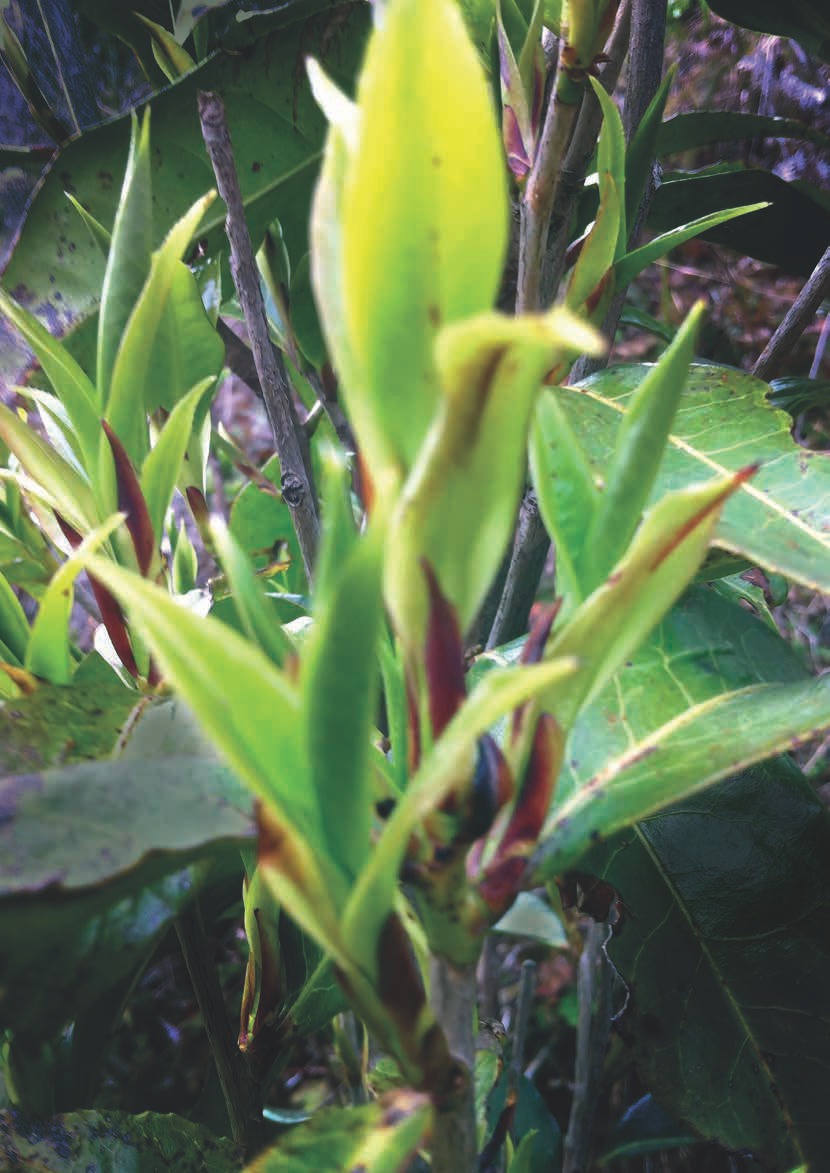

The main feature that distinguishes red tea is a very heavy withering, causing as much oxidation as possible. This heavy oxidation is achieved during the processing/drying stages of the leaf. Oxidation is an enzymatic process: basically, cellular breakdown due to, of course, the exposure to oxygen, like when a banana or apple turns brown on the counter. Oxidation can be spontaneous or controlled and can have a positive or negative influence on the quality of a tea. The change in the leaves after harvest is spontaneous oxidation. Controlled oxidation happens during the withering, rolling and piling phases. Proper oxidation in tea production requires an abundance of moist, oxygen-rich air. For red tea production, oxidation rooms (or long vats with fans and/or heaters) must provide ample humidified air to promote heavy oxidation. The polyphenols in the leaf (tea catechins) bond to oxygen molecules during the early stages of oxidation.
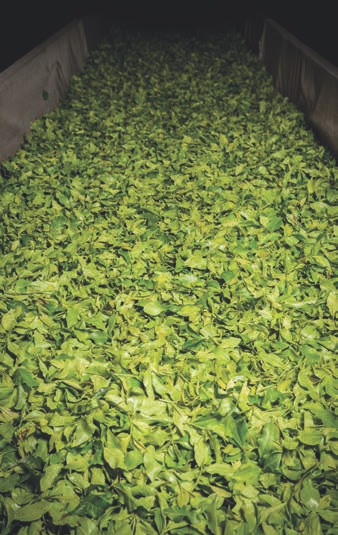
These days, the withering of red tea most often takes place in long troughs that have fans that blow warm humid air over the leaves. However, in Yunnan, farms are often still very simple and lack machinery, so the tea is often just left on the ground in a pile to wither. If a farmer is going to wither without machinery, it is ideal to pile the tea on round bamboo mats held up on racks, as this will allow more air flow from underneath.
There are many chemical reactions that comprise oxidation. The oxygenation of polyphenols starts a series of chemical reactions that change the flavor of the leaf more towards red tea. Tea expert and Global Tea Hut member Robert Heiss expresses these changes better than us: "The enzymes polyphenol oxidase and peroxidase act on other polyphenols to produce theaflavins. These red-orange compounds then react with more polyphenols to produce thearubigins, the chemicals responsible for changing the leaf 's color from green to golden, coppery, or chocolate brown. The thearubigins, meanwhile, are also busy reacting with some of the amino acids and sugars in the leaf, creating the highly polymerized substances that develop into the various and distinctive flavor components that we expect in red tea. In general, theaflavins contribute to the brisk and bright taste of red tea, while the thearubigins are what provide strength (depth or body) and color. If the temperature of the leaf is allowed to rise too high, the controlled oxidation will rage out of control; and if it falls too low, oxidation will cease." Usually, the pile of withering tea is stirred to control the temperature and oxidation degree.
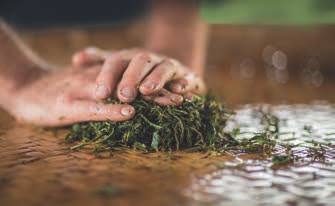
The oxidation of the tea then continues into the next stage of rolling. Rolling can be done by machine or, more rarely, by hand. This breaks the cell walls down and releases the essential oils that make red tea darker, allowing oxygen to interact with these otherwise trapped chemical components. Rolling also shapes the tea, so the method of rolling will determine the final shape of the tea. For most red teas, this is done for up to ninety minutes, but experts will of course judge by looking at and smelling the leaves.
Optionally, red tea is then piled again after rolling to increase oxidation, usually on round bamboo mats, to a thickness of twenty centimeters or so. This additional oxidation results in further changes in the tea's flavor, aroma, color and impact on Qi when drunk.
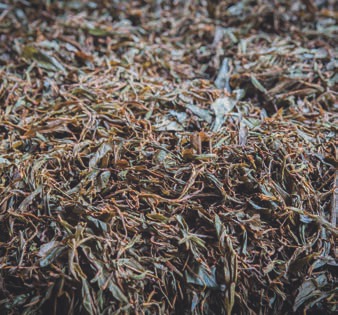
Finally, red tea is dried. Most red teas are baked dry in ovens. However, dian hong is more often sun-dried like puerh. The baking/sun-drying arrests the oxidation and finishes the tea (oxidation actually does not stop completely, but slows to a pouring-honey-slow crawl). Some areas will also include sorting in various phases of the processing, but this usually occurs after the tea is dried to remove mis-processed or broken leaves before final packaging. Dian hong is rarely sorted.
"Dian (滇)" is an aboriginal word for "Yunnan" and "hong (紅)" is, of course, red, so this term applies to any red tea produced in Yunnan. It may surprise you that Yunnan produces red tea, since it is famous for puerh tea. Throughout the twentieth century, Yunnan produced much more red tea than puerh, until the boom in the early 2000s. In the late nineties, there were hardly any puerh shops in Kunming, and the locals drank much more red and green tea. Now, of course, there are puerh shops everywhere, including the airport.
Any tea can be processed like a red tea, and while the process may seem complicated, it is actually one of the simplest kinds of tea to make: pluck and oxidize heavily. Since dian hong starts out as puerh raw material (maocha, 毛茶), its quality is determined in much the same way, which means that the terroir and the age of the trees play a huge role in evaluating dian hong. Some of you will remember our discussions of trees and gardens in Yunnan, in which we said that like most things in the tea world, there are no standard ways of discussing tree ages or garden types (and like most things tea, the trends that do exist are often misleading and/or incorrect).
Understanding the age of the tree, the mountain the tea came from and the kind of garden are essential in puerh tea and, by extension, dian hong. Most teas have a ratio between the terroir/trees/raw material and the processing skills that create the final quality. This ratio is different in each genre. In oolong, for example, quality is half and half. But in puerh and dian hong, as much as ninety percent of the quality of any tea is in the raw material - the terroir. We call trees above one hundred years "old-growth" and trees around one thousand years "ancient." We then divide gardens into the three main categories of "plantation," which are industrially grown, rarely sustainable rows of cuttings; "eco-arboreal," which are semi-wild, seed-propagated gardens on the edges of villages between the forest and homestead; and "forest gardens," which can be wild or human-made, but are in the jungle proper with all its biodiversity and life. While there has been a lot of plantation red tea produced in Yunnan for centuries, old-growth dian hong are the best examples of living dian hong.
Dian hong is distinct from other kinds of red tea in the same ways as puerh. Puerh maocha is unique because the firing (sha qing, 杀青) is done at a lower temperature for a shorter duration so that the heat-resistant spore colonies essential in the post-production fermentation will survive. The tea is then sun-dried so that the light and heat will reactivate the microbes and fermentation will begin. Dian hong has no firing stage and no de-enzyming, so the microbe-dense leaves, which are covered in hundreds of species of molds and bacteria before harvest, are even more active. Like puerh, dian hong is sun-dried, which gives the tea a unique flavor and leaves the microbes active.
Dian hong is most often malty and rich, brisk and energetic. The color of the leaves ranges from dark bluish-black to bright gold, and the tea can be made of buds or sets of leaves and buds. The liquor often brews a dark or bright red and can be cloudy due to a lack of production skill and quality control in Yunnanese tea production, especially if the tea is made simply in the village. But no one drinks a dian hong looking for refinement; if you are seeking that in a red tea, drink a "gongfu red tea (功夫紅茶)" from Anhui or Fujian, like June's Tea of the Month, Red Sun Rising. Dian hong is strong and vibrant. It moves the Qi - briskly and vibrantly.
Dian Hong & Sheng Puerh
The best qualities dian hong has to offer are in many respects similar to puerh: old trees and deep Qi with a strength due to the heavy oxidation, which releases the deep energy of a dian hong in the same way aging puerh tea does - only aged puerh is yin and red tea processing results in yang tea. You could think of dian hong as the counterpart to aged puerh. Both release more of the deeper, dark essence of the tough, large leaves of Yunnanese species, but dian hong does so through oxidation during processing, making it vibrant and young, while the slow and graceful aging of sheng puerh releases the same depths more softly and gently. Energetically, this is also true: dian hong is vital and strong, and aged sheng puerh is deep, soft and soothing in a feminine way.
This is a vital and deep way of thinking of the relationship between fermentation and oxidation, or dian hong and aged sheng puerh. Oxidation is an enzymatic process, during which oxygen is absorbed and causes changes to the leaves. Fermentation is anaerobic, microbial activity involving one or more types of bacteria, molds and/or yeasts. Usually, this results in alcohol, but not in tea production. Aged sheng has also undergone enzymatic oxidation, but very slowly over time. This, along with fermentation, results in a very yin tea. Dian hong red tea processing, on the other hand, has only undergone oxidation, resulting in a greater, heavier cellular breakdown forcibly and while the tea is young. Both result in dark liquors, one black and one red, but aged sheng is soft and billowy, deep and quiet as a mountain cave, while dian hong is invigorating, like a run through the park on the first afternoon that really feels like summer.
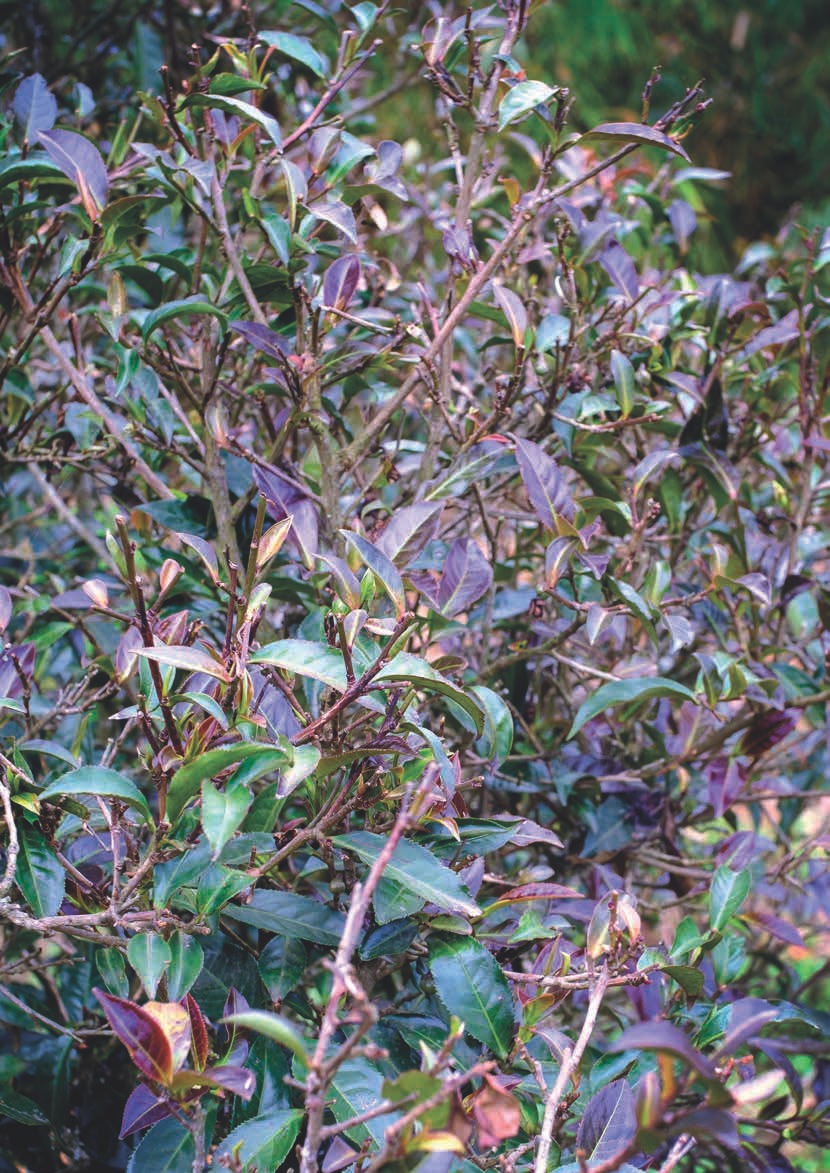
This month, our tea comes from the Mangshi Township in the Dehong Prefecture of Yunnan, a province in southwest China, which is, as we have discussed, the birthplace of all tea. Dehong is one of eight autonomous prefectures in Yunnan, bordering Myanmar to the west. The Dai and Jingpo tribes abound throughout the area.
Evening Sky is made from the "Wild Purple (Ye Sheng Zi, 野生紫)" varietal, also known as Camellia sinensis var. Assamica Dehongensis. Its potency and incredible Qi arise from its unadulterated nature. It is naturally bug repellent, and grows wild in the forests of Yunnan at an altitude of 1,600 - 2,200 meters. Some of the trees are old-growth, ranging in the hundreds of years old. This tea comes from natural, seed-propagated and wild gardens. Our Tea of the Month comes from trees that are between the ages of forty and two hundred. Only a few trees are two hundred, so most of the tea is made from younger trees. (One of the oldest trees is shown on the back cover.) The maocha is often very bitter when it is processed as sheng puerh (and drunk fresh/young), but sweet and fruity as red tea. This tea also ages faster than ordinary Assamica, developing aged subtlety and complexity faster than a lot of sheng puerh or other dian hong teas. (We will be offering a wild, all-bud version from deeper in the forest as an Expansion Pack. Check pages 37-38 or the website for availability!)
That it predates the varietal of Camellia that we normally assume to be "tea" (Camellia sinensis) raises interesting questions about what it even means to say that a leaf is "tea." The categories we use to separate these varietals are, of course, arbitrary. This lineage of trees is unique enough that it is considered by biologists to be a separate varietal, but not a unique species, as it can still reproduce/ cross-pollinate with other Camellia sinensis.
Normally, teas such as this one are processed like puerh tea. This purple-bud varietal of puerh is found throughout Yunnan and was even mentioned in Lu Yu's Tea Sutra, the oldest surviving book on tea. It took a gifted tongue to realize that the tea from this garden would rather be red tea. (We have drunk its puerh version, so we know from firsthand experience.) You won't need to trust us, however, for as soon as you open your tin and smell this remarkable tea, you'll wonder how it ever could be processed any other way.
This unique "Purple Bud," old-growth, wild red tea is out-of-this-world flavorful. It erupts in a bouquet of fruity, flowery notes that expand seemingly endlessly. There are peachy-fruity nuts, berries and flowers in the bouquet. The complexity of this tea is astounding. You haven't ever had anything quite like it. The Qi is fanciful and uplifting, which is rare for a red tea, but this tea breaks all the molds. You can brew it almost any way, and you'll find it responds well. We drink it in bowls or steep it in a sidehandle pot. It is very patient, especially for a red tea. Therefore, be sure to give yourself a whole morning to enjoy it. Like most great teas, the glorious fragrance of this tea is so much better shared with a friend or loved one.

This glorious dian hong is very forgiving - easy to brew, in other words. You can't really go wrong with this kind of tea. It can be brewed leaves in a bowl or steeped Western style or in a sidehandle pot. We would recommend using a sidehandle and steeping this tea into bowls. You can actually also brew this tea gongfu if you want, though we very rarely do so.
We have found that the flowery, peachy fragrance is enhanced by using fewer leaves in a large pot, with longer steepings that grow slowly over the session. Try lightly covering the bottom of a larger pot like autumn leaves - covering the bottom, but you can still see it. Then steep the tea longer, from one minute to several as the session progresses. Don't give up on this tea when it moves from red liquor to golden, as there are some deep, jungly, minerally surprises in these later steepings - not to mention a nice fragrance and Qi. We always steep this tea until it is water. The light fragrances of the earth, rocks and altitude of this healthy tea really shine in these later steepings. Since we will be using fewer leaves in a larger pot, with room for the leaves to expand and steep for a longer period, it is important to remove the lid between steepings. This is nice with green and red teas when you will be sipping for longer, your pot is large and leaf ration less. If you don't remove the lid between pours, the leaves will steam inside. This long steaming will reduce the patience of the tea. Worse, it will discourage the fruity, flowery fragrance of this tea. Also, the tea will begin to taste of boiled tea over the course of the session, losing the natural movement from purplish-red to golden liquor. A similar degradation occurs with very fresh, young sheng puerh or other green or white teas when using a large sidehandle pot. You can also apply this to brewing such teas gongfu, though it is not always necessary since the steepings are quicker, the pot smaller and the cups drunk up faster, reducing the time between pours (and therefore, decreasing the time the leaves are steaming in the pot). In this way, this month's tea will stay sweet for many steepings.